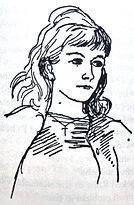
Up the Junction, Nell Dunn, 1963


All drawings: by permission of Susan Campbell
Sticky with sweets, beer and nylon, you won’t get much change out of Battersea girls Lily, Rube, and Sylvie in Nell Dunn’s Up the Junction. They’re too busy clubbing and gossiping through the grim terraces and past the railway yards now gentrified beyond even their Saturday night fantasies. This book is a skip and a stumble from Lavender Hill to Falcon Road and on to Clapham Common, when inner south London was still industrial, and its people close, coarse and insular. Written in working class Battersea vernacular, we eavesdrop on the intimate lives of three young women. Sometimes it’s hard to work out whose speaking as the dialogue tumbles across the page following the girls tottering around Battersea, in pursuit of quick pleasure - dancing, drinking, men - to escape dull reality.
What happens? Where do we want to take you with Up the Junction. First you need to imagine Battersea Power Station is just that, not a mall with apartments attached. Then, demolish in your heads all the towers from Waterloo to Wandsworth until all that’s left is the Price’s Candles factory at Nine Elms, soot-drenched locomotive sheds, and Local Authority Estates and the trains. Now you’ve got the low-lying terrain of railways and tram line terraces, and our heroes in mini skirts at work and public house. Think Michael Caine’s Alfie, re-runs of Dennis Waterman police dramas, and Ealing Comedies.
Perhaps you’ve guessed this is a laughing and crying book. Small squashed and squalid lives fighting to escape, only reaching the little shops stacked near Clapham Junction station. Buildings, spaces, dialogue are all precarious, worn, hiding their potential. Not surprisingly much of the brilliance is enclosed. It’s in the engraved mirrors of the public houses, the cellophane clad candy gems of McCrindles sweet factory where the girls work, the sequinned clip joint. London, before modern mayors, had public houses with dancing entertainment and worse in most suburbs. All for cash in uncomfortable situations now shut down and moved online. The closest night spot like this in recent times is the Vauxhall Tavern, a cultural place of painted faces just a step away from the Junction.
London was never really black and white even if it was dirty, but it was a city of treacherous holes small as puddles and big as bomb sites. In Up the Junction we reel from one suburban void to another, looking for colour, fun, love. It’s never easy. It’s not happy for long, and - like the land-locked terraces and alleys and bridges traversed by Lily, Silvie, and Rube in their clackety clack clogs competing with the staccato trains overhead, we never get further than ‘a transport cafe on an arterial road…where…in the gathering dark boys kissed their girls.’ The bikes: Triumph 500s, BSA Gold Stars, the Bonnevilles’ Boys hammering up the tarmac.
Go now, and you’ll find a Clapham Junction of two conflicting worlds. There are estates striding across the terraces and overwriting the land of Up the Junction, and there are streets around Battersea brushed up by transport connections and developers as the place leans ever-closer to Chelsea. To look for Lily, Sylvie, and Rube you’ll have to re-read Up the Junction.
If you haven’t already bought Up the Junction, or want to see other titles we think you’ll like,
See you next post, starting in a book.



